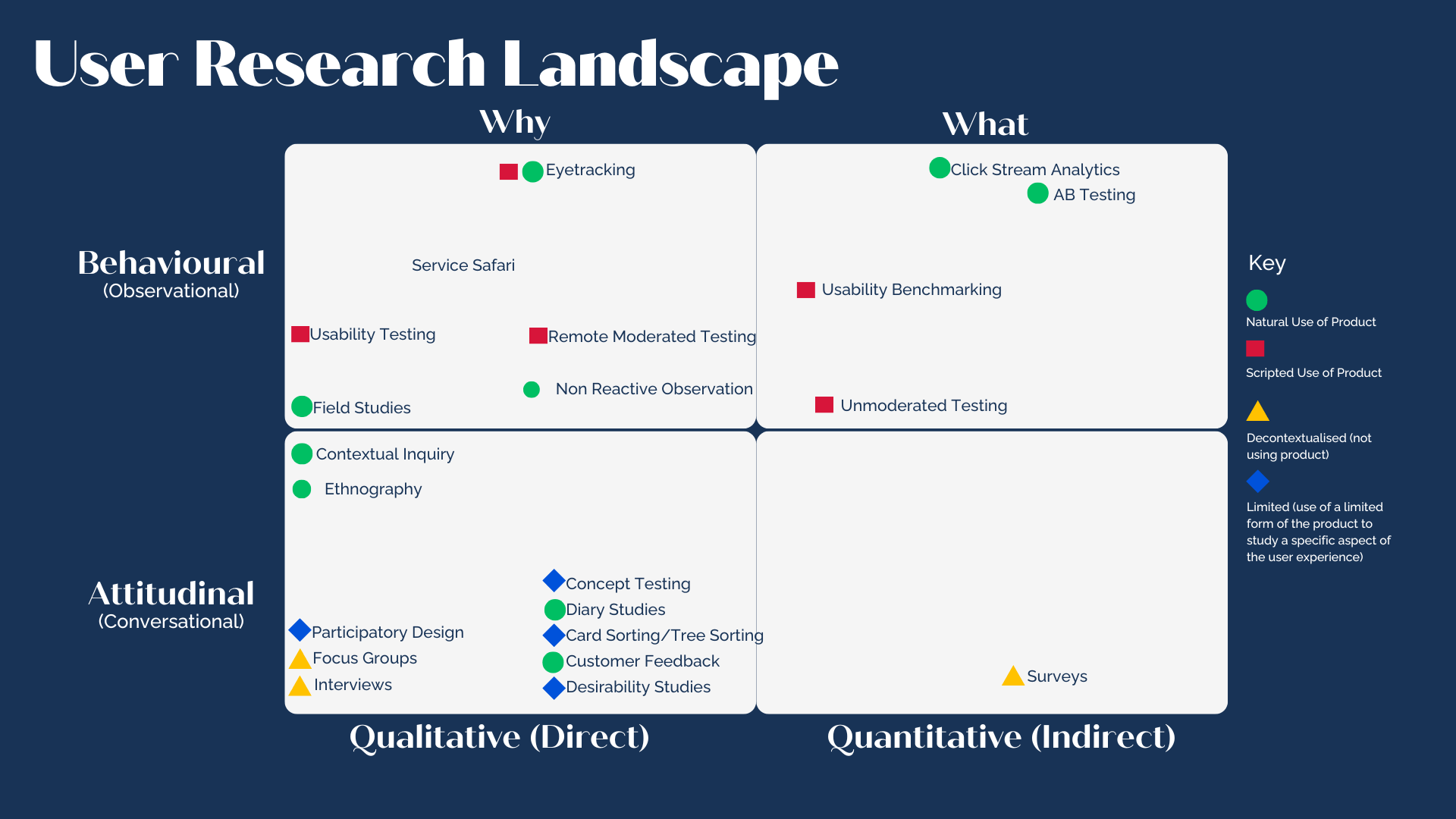In the modern organisation of today, where most have products that customers use, I feel strongly that we should all be learning more about research, allowing us to deeply understand what our customers want, need and struggle with, when it comes to our products.
Exploring the Many Faces of Research
Research is a vast and varied field that spans an incredible range of methods, activities, and timeframes. Some research projects stretch out over years, like longitudinal studies that follow the same participants at regular intervals to track changes over time. Other types of research are swift and focused, such as usability tests that might take just hours or days to complete.
The settings for research can be just as diverse. Some take researchers into exotic environments, immersing them in the lives and cultures of their subjects; this is ethnographic research. Other times, research happens at a desk, where reports, articles, and even software interfaces are analyzed for insights.
To make sense of this wide spectrum, research can be categorized into three key dimensions: primary versus secondary, quantitative versus qualitative, and observational versus attitudinal. These categories serve as a guide, helping researchers choose the right approach for their specific goals and contexts.
Primary vs. Secondary Research
The first dimension, primary versus secondary research, distinguishes between the source of the data.
- Primary research involves collecting data firsthand through your own activities. For example, running an online survey, analyzing Google Analytics, or organizing a usability study.
- Secondary research relies on data that already exists, often collected by someone else. This might include raw data, such as government statistics, or analyzed data, like reports or academic papers.
Both types of research have their place. Primary research is often invaluable when seeking fresh insights tailored to your unique questions, while secondary research provides a wealth of context and background, leveraging what has already been learned.
Quantitative vs. Qualitative Research
The second dimension, quantitative versus qualitative research, addresses the type of data and the depth of understanding sought, both are great and each has their place in research, but there are different reasons for using one over the other.
- Quantitative research is all about numbers. It provides structured, measurable data that is statistically significant. Think of political opinion polls, where a large sample of people are asked straightforward questions like, "Which party will you vote for?" The results can be plotted on charts, offering clear, objective insights. It provides the what and how.
- Qualitative research, on the other hand, delves into the “why” behind the numbers. Through interviews, focus groups, or open-ended discussions, qualitative research explores motivations, emotions, and experiences. It’s unstructured and messy, but it provides deep, contextual understanding.
When combined, these two approaches; known as mixed methods research, paint a comprehensive picture. For instance, a political party could use quantitative data to measure voter support trends and qualitative methods to explore why those trends are shifting.
The third key dimension of research to understand, is observational versus attitudinal approaches, where observational is literally observing someone's actions and attitudinal is them telling you what they think; all of these categories intersect to form a complete research landscape.
The categories we've seen; qualitative versus quantitative and observational versus attitudinal can be used to represent the research landscape, by turning them into 2 axes that split the research space into 4 quadrants each, and every research method available to us can be plotted in a diagram like this:

The Debate: Qualitative vs. Quantitative Research
When it comes to understanding users and designing meaningful experiences, qualitative research is often the hero. As a researcher, much of your work will rely on qualitative methods but knowing what people do is only part of the equation. To create products that genuinely solve user problems, you must also uncover why people behave the way they do. Yet, qualitative research often finds itself sidelined, unfairly labeled as the “poor cousin” of quantitative research. In today’s data-driven world, quantitative methods are celebrated as the gold standard. They’re seen as rigorous, objective, and capable of revealing universal truths, thanks to their reliance on large sample sizes, numerical data, and statistical rules.
Qualitative research, on the other hand, faces criticism. Its smaller sample sizes, unstructured data, and reliance on interpretation are often misunderstood as unscientific or lacking rigor. The richness of qualitative insights is overshadowed by skepticism, especially from those more familiar with quantitative principles. However, qualitative research is just as important to do, so keep that in mind when considering research methods.
As you dive into qualitative research, you’ll likely encounter questions that stem from a misunderstanding of its goals and methods. For instance:
- "If you only interviewed six people, how can you be sure they represent your entire user base?"
The answer is simple: they don’t. Representation isn’t the goal of qualitative research. - "If you conducted usability testing with five participants, how can you be confident other users will encounter the same issues?"
You can’t. But again, qualitative research isn’t about statistical certainty.
These questions reflect an attempt to impose quantitative standards on qualitative work—a mismatch that fails to acknowledge their fundamental differences. It’s essential to remember that qualitative and quantitative research serve distinct purposes. They differ in their goals, sample sizes, data collection methods, analysis techniques, and the type of knowledge they produce. Both have their strengths and limitations, and when used together, they offer a more complete understanding of user behavior and needs. With qualitative research, the focus isn’t on proving a universal truth. Instead, it’s about exploring rich, contextual insights—getting to the heart of user motivations, emotions, and experiences. And that’s where its true value lies.
An Overview of Research Methods
User research involves a spectrum of methods, each offering unique insights into user needs and behaviors. To understand how these methods contribute to UX research, it’s important to distinguish between qualitative and quantitative approaches. Both have distinct characteristics, purposes, and applications, and together, they provide a comprehensive view of user experiences.
Qualitative Research Methods
Qualitative methods gather non-numerical data to uncover insights into users’ attitudes, beliefs, and motivations. These methods are often categorized as observational or attitudinal.
Observational Methods
Observational methods aim to understand what people do by watching their behavior in natural or controlled environments.
- Usability Testing: Observing users as they complete tasks with a product or prototype highlights usability issues and pain points. This method can be conducted in person or remotely and provides actionable insights into design improvements.
- Contextual Inquiry: Researchers observe users in their natural environments, such as a library or an airport, while asking questions to understand their actions and decisions. This approach combines observation with real-time interaction, making it highly insightful.
- Ethnography: involves immersive, long-term participation in a community to gain a deep understanding of user behavior and context.
- Service Safaris: Researchers experience a product or service as users themselves, identifying friction points and areas for improvement from a first-hand perspective.
- Non-Reactive Observation: Also known as unobtrusive observation, this method involves watching users without their awareness, ensuring natural behavior but limiting opportunities for clarification.
Attitudinal Methods
Attitudinal research focuses on what people say and how they think.
- Interviews: Interviews allow researchers to delve into users’ thoughts, opinions, and past experiences. However, this method is less effective for understanding actual behaviors, which are better captured through observational techniques.
- Participatory Workshops: By involving users in the design process, workshops foster collaboration and ensure that solutions align with user needs.
- Card Sorting: This technique helps refine information architecture by revealing how users categorize and prioritize content.
- Diary Studies: Users document their experiences over time, providing longitudinal insights into their interactions with a product or service.
Quantitative Research Methods
Quantitative research gathers numerical data from large sample sizes to identify trends and patterns. These methods are also categorized as observational or attitudinal.
Observational Methods
- Analytics: platforms track metrics like clicks, time spent on pages, and user flows, providing objective insights into user behavior at scale.
- A/B Testing: compare two versions of a product or feature to determine which performs better, offering robust validation of design decisions.
Attitudinal Methods
- Surveys: capture quantifiable user feedback on preferences, behaviors, and perceptions. While scalable and cost-effective, surveys often lack the depth of qualitative methods.
Conclusion
The landscape of UX research is rich with methods that cater to different goals and contexts. While this diversity may seem overwhelming at first, it becomes manageable with study and practice. To build confidence, start with foundational methods like interviews and usability testing. Over time, incorporate more advanced techniques to expand your toolkit. Remember, the more tools in your toolkit that you have at your disposal, the better you will become at research. User research thrives on curiosity and adaptability. As you deepen your understanding, explore resources and case studies to refine your approach. Remember, every method has its strengths, and the best research often combines multiple methods to gain a holistic view of users’ needs and experiences. With these tools, you’ll be well-equipped to create products that truly resonate with your audience.


0 Comments